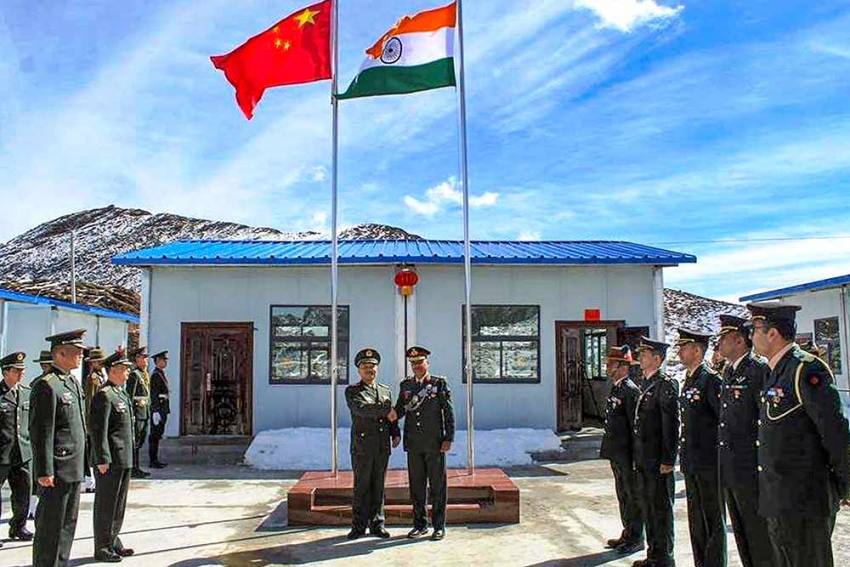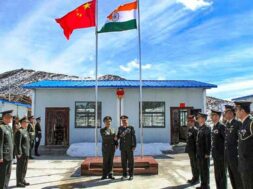
Manas Dasgupta
NEW DELHI, Jan 25: Contrary to the Centre’s claims that India has not conceded an inch of land along the Line of Actual Control with China, a senior police officer of Leh has pointed out that India has lost access to 26 of the 65 patrolling points (PP) in Eastern Ladakh because of China claiming the areas as “buffer zones.”
The police officer has suggested that India must counter China’s “inch-by-inch” aggression method with “no fall back” strategy by increasing civilian and army presence on the border areas. “We should be prepared to counter their “inch-by-inch capture” strategy with our no fall-back strategy. This is even applicable to the buffer zones which informally become PLA patrolling areas and they stake their claims over the years,” PD Nitya, the Superintendent of Police of Leh, Ladakh’s main city, said in a research paper filed at the annual conference of the country’s top police officers held in Delhi last week.
The three-day conference was attended among others by the Prime Minister Narendra Modi, the Union Home Minister Amit Shah and the National Security Advisor Ajit Doval. The conference covered various aspects of policing and national security, including counter-terrorism, counter-insurgency and cyber security.
Her report has come as a worrying new disclosure amid the country’s standoff with China at various flashpoints along their tottery 3,500-km frontier. “Presently there are 65 PPs (Patrolling Points) starting from Karakoram pass to Chumur which are to be patrolled regularly by the ISFs (Indian Security Forces). Out of 65 PPs, our presence is lost in 26 PPs (i.e. PP nos. 5-17, 24-32, 37, 51, 52, 62) due to restrictive or no patrolling by the ISFs,”
“Later on, China forces us to accept the fact that as such areas have not seen the presence of ISFs or civilians since long, the Chinese were present in these areas. This leads to a shift in the border under control of ISFs towards Indian side and a “buffer zone” is created in all such pockets which ultimately leads to loss of control over these areas by India. This tactic of PLA (China’s People’s Liberation Army) to grab land inch-by-inch is known as ‘Salami slicing’,” it said.
“PLA has taken advantage of the buffer areas in the de-escalation talks by placing their best cameras on the highest peaks and monitoring the movement of our forces. This peculiar situation can be seen at Black top, Helmet top mountains in Chushul, at Demchok, at Kakjung, at Gogra hills in Hot springs and at Depsang plains near Chip Chap river,” the report said.
“With the ‘Salami Slicing’ strategy they object to our movement even in the buffer zone, claiming it to be ‘their’ area of operation and then further ask us to move back to create more ‘buffer’ areas. This situation has happened with Y nallah at Galwan where we were forced to move back to Camp-1 without dominating the higher posts overseeing Y nallah; at Chushul the BPM hut near the airfield has become the de-facto LAC and Nilung Nallah at Demchok has been restricted,” it added.
She said this Chinese strategy was seen in Galwan Valley, the site of a deadly clash in 2020 when 20 Indian troops and at least four Chinese soldiers died in hand-to-hand fighting. Ms Nitya also said marking areas as out of bounds and keeping them barren affects troop morale as well.
According to the report, the extremely harsh climate, difficult terrain, and remoteness of the area affect the morale and motivation of jawans and officers on the ground which only reminds them to start a reverse countdown of their deployment time and each unit wants to complete their tenure and return back to plains.
“In a longer duration, they don’t see the utility to defend barren acres of land when no population and no economic activity is being carried out, therefore, the onus is on us to keep up their motivation and morale high. During an interaction with one senior officer whose unit is based right on the forward area, he shared that, if by retreating 400 mts back we can buy peace with the PLA for four years then it’s worth it,” the report states.
The Indian Army, according to the report, has placed many restrictions on the movement of civilians and grazers near the forward areas on the Indian side, indicating their ‘play safe’ strategy that they do not want to annoy PLA by giving them the chance to raise objections on the areas being claimed as disputed.
“Till September 2021, senior officers of the district administration and security forces would easily patrol till Karakoram Pass (35 km from DBO) in the DBO sector, however, restrictions in the form of check posts were placed by the Indian Army since December, 2021 at DBO itself to stop any such movement towards Karakoram Pass as PLA had installed cameras and they would immediately raise objections on the movement from Indian side if not informed beforehand. This form of restrictive approach has affected our assertiveness and areas which were much accessible from our side became an informal ‘buffer’ zone,” the report said.
Recently the deal of disengagement achieved at PP 15,16, by ISFs resulted in the loss of pasture lands at Gogra hills, while the same has been lost in the north bank, Kakjungareas. Over the years, this has resulted in the loss of livelihood and change in lifestyle patterns of border villages which has led to migration. Shrinking grazing areas also leads to infighting within communities, for example, the Rebos of Chumur cannot go beyond Nepali Basti for grazing and come in conflict with the Korzok area Rebos who refuse to allow them in their grazing areas. These issues also badly affect the civil-military liaison,” the report said.
Nitya concluded by stating that given the domestic compulsions of CPC (Covid-19, protests, etc) in China and their economic interests in the region, PLA would continue to build up its military infrastructure and skirmishes would also get frequent which may or may not follow a pattern.
“We should be prepared to counter their “inch-by-inch capture” strategy with our no fall-back strategy. This is even applicable to the buffer zones which informally become PLA patrolling areas and they stake their claims over the years. The unfenced border security cannot be just compensated with increasing the number of men in boots, but a multi-pronged approach like rural development, tourism attraction, infrastructure build-up, and schemes like model border villages to develop the border areas including the concerns of the local populace and economic interests needs to be taken up,” she said in the report.
“Rather than thinking in offensive and defensive terms, LAC needs to be dealt with a ‘positive’ approach giving importance to civilian needs as well as military requirements.”
The government is yet to comment on the disclosure but defence sources countered the police officer’s assertions saying that “there is no loss of territory due to disengagement in friction areas.” “Some areas have been restricted for patrolling for both sides pending diplomatic resolution of disputes. No pasture lands have been lost. In disengaged areas, we have as many cameras and technical means as the PLA and hence dominate the area as much, if not more,” the sources claimed.
They said the military was “encouraging and providing all facilities”, in conjunction with the civilian administration, to allow locals and their cattle in grazing locations.
The report comes just over a month after India accused China of trying to “unilaterally change the status quo” on their de-facto border, known as the Line of Actual Control, when clashes left troops on both sides injured. The December 9 incident in Arunachal Pradesh was seen as the most serious face-off since the Galwan Valley clash in 2020 which led to a sharp escalation in hostilities between the two countries. A series of military talks since then have led to a careful pullback of troops on both sides.













